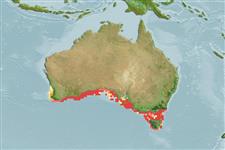>
Gobiesociformes (Clingfishes) >
Gobiesocidae (Clingfishes and singleslits) > Incertae sedis
Etymology: Aspasmogaster: Greek, aspasma, -atos = the loved objetc + Greek, gaster = stomach (Ref. 45335).
More on author: Günther.
Environment: milieu / climate zone / depth range / distribution range
पारिस्थितिकी
समुद्री ड़िमरसल. Subtropical
Eastern Indian Ocean: west coast to Australia to Victoria and Tasmania.
आकार / वज़न / Age
Maturity: Lm ? range ? - ? cm
Max length : 8.0 cm TL पुल्लिंग / अलिंग; (Ref. 9002)
Short description
आकृति विज्ञान | मौरफोमैटरिक्स
पृष्ठीय रीढ़ (सम्पूर्ण): 0; पृष्ठीय सौफट रेज़ (सम्पूर्ण): 8-10; गुदा कांटा 0; ऐनल सौफट रेज़: 7 - 9. Caudal fin rounded (Ref. 9002). Pelvic fins united into moderate-sized double sucking-disc, posterior half with fleshy margin (Ref. 9002). Color variable, pinkish to brownish or greenish, usually with distinct regular dark bands across head and back (Ref. 9002).
Occurs in shallow coastal and rocky estuaries, often under rocks (Ref. 9002).
Life cycle and mating behavior
परिपक्व अवधि | पुनरुत्पत्ति | मछलीऔ का अंडे देना | अंडे | Fecundity | लार्वा
Kuiter, R.H., 1993. Coastal fishes of south-eastern Australia. University of Hawaii Press. Honolulu, Hawaii. 437 p. (Ref. 9002)
IUCN Red List Status (Ref. 130435)
Threat to humans
Harmless
Human uses
अधिक जानकारी
आम नामउपशब्दचपायचयपरभक्षीईकोटोकसीकोलौजीपुनरुत्पत्तिपरिपक्व अवधिमछलीऔ का अंडे देनाSpawning aggregationFecundityअंडेEgg development
Age/Sizeबाढ़Length-weightLength-lengthLength-frequenciesमौरफोमैटरिक्सआकृति विज्ञानलार्वालारवल गतिकीभर्तीबहुतायतBRUVS
संदर्भजलीयकृषिजलीयकृषि रूपरेखाखींचआनुवंशिकीElectrophoresesहैरेटिबिलटीबीमारीप्रक्रमणNutrientsMass conversion
सहयोगीयोतस्वीरेStamps, Coins Misc.ध्वनिसिगुयटिरारफ्तारतैरने के प्रकारगिल क्षेत्रOtolithsदिमागदृष्टि
साधन
Special reports
Download XML
इंटरनेट स्रोत
Estimates based on models
Preferred temperature (Ref.
123201): 14.4 - 18.4, mean 16.8 °C (based on 96 cells).
Phylogenetic diversity index (Ref.
82804): PD
50 = 0.5625 [Uniqueness, from 0.5 = low to 2.0 = high].
Bayesian length-weight: a=0.00389 (0.00180 - 0.00842), b=3.12 (2.94 - 3.30), in cm total length, based on all LWR estimates for this body shape (Ref.
93245).
Trophic level (Ref.
69278): 3.3 ±0.3 se; based on size and trophs of closest relatives
लौटाव (Ref.
120179): माध्यम, न्यूनतम जनसंख्या दुगनी होने का समय 1.4 - 4.4 वर्ष। (Preliminary K or Fecundity.).
Fishing Vulnerability (Ref.
59153): Low vulnerability (10 of 100).
Nutrients (Ref.
124155): Calcium = 213 [108, 474] mg/100g; Iron = 1.3 [0.7, 2.4] mg/100g; Protein = 17.4 [16.3, 18.5] %; Omega3 = 0.317 [0.171, 0.591] g/100g; Selenium = 17 [7, 43] μg/100g; VitaminA = 41.3 [11.1, 143.8] μg/100g; Zinc = 1.39 [0.91, 2.10] mg/100g (wet weight);
